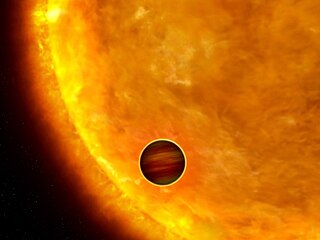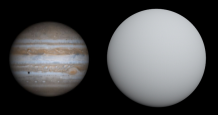
CoRoT was a space telescope mission which operated from 2006 to 2013. The mission's two objectives were to search for extrasolar planets with short orbital periods, particularly those of large terrestrial size, and to perform asteroseismology by measuring solar-like oscillations in stars. The mission was led by the French Space Agency (CNES) in conjunction with the European Space Agency (ESA) and other international partners.
HD 147506, also known as HAT-P-2 and formally named Hunor, is a magnitude 8.7 F8 dwarf star that is somewhat larger and hotter than the Sun. The star is approximately 419 light-years from Earth and is positioned near the keystone of Hercules. It is estimated to be 2 to 3 billion years old, towards the end of its main sequence life. There is one known transiting exoplanet, and a second planet not observed to transit.

CoRoT-1b is a transiting extrasolar planet approximately 2,630 light-years away in the constellation of Monoceros. The planet was discovered orbiting the yellow dwarf star CoRoT-1 in May 2007. The planet was the first discovery by the French-led CoRoT Mission.
HAT-P-6 also named Sterrennacht is a star in the constellation Andromeda, located approximately 895 light years or 274 parsecs away from the Earth. It is an F-type star, implying that it is hotter and more massive than the Sun. The apparent magnitude of the star is +10.54, which means that it can only be visible through the telescope. The absolute magnitude of +3.36 is brighter than the Sun's +4.83, meaning that the star itself is brighter than the Sun. A search for a binary companion star using adaptive optics at the MMT Observatory turned out negative.

HAT-P-6b is a transiting extrasolar planet discovered by Noyes et al. on October 15, 2007. It is located approximately 910 light-years away in the constellation of Andromeda, orbiting the star HAT-P-6. This hot Jupiter planet orbits with a semi-major axis of about 0.05 AU, and takes 92 hours, 28 minutes, 17 seconds to orbit the star. It has true mass of 5.7% greater than Jupiter and a radius 33% greater than Jupiter, corresponding to a density of 0.583 g/cm3, which is less than water.

CoRoT-2b is the second extrasolar planet to be detected by the French-led CoRoT mission, and orbits the star CoRoT-2 at a distance of 700 light years from Earth towards the constellation Aquila. Its discovery was announced on 20 December 2007. After its discovery via the transit method, its mass was confirmed via the radial velocity method.
WASP-11/HAT-P-10 is a binary star. It is a primary main-sequence orange dwarf star. Secondary is M-dwarf with a projected separation of 42 AU. The system is located about 424 light-years away in the constellation Aries.

CoRoT-3b is a brown dwarf or massive extrasolar planet with a mass 21.66 times that of Jupiter. The object orbits an F-type star in the constellation of Aquila. The orbit is circular and takes 4.2568 days to complete. It was discovered by the French-led CoRoT mission which detected the dimming of the parent star's light as CoRoT-3b passes in front of it.
CoRoT-4 is a yellow-white dwarf main-sequence star in the constellation Monoceros.
XO-2 is a binary star system about 490 light-years away in the constellation Lynx. It consists of two components, XO-2N and XO-2S, both of which host planetary systems.

CoRoT-1 is a yellow dwarf main sequence star similar to the Sun. The star is located approximately 2,510 light-years away in the constellation of Monoceros. The apparent magnitude of this star is 13.6, which means it is not visible to the naked eye; however, it can be seen through a medium-sized amateur telescope on a clear, dark night. The first exoplanet discovered in the course of the CoRoT mission orbits this star; it is considered to be a "hot Jupiter", and is approximately as massive as the planet Jupiter itself.
CoRoT-7 is a binary star system made up of a late G-type star and a M-dwarf star that was discovered in 2021. The primary star has three exoplanets, including CoRoT-7b, an super-Earth exoplanet that is remarkable due to its extremly high temperature and very short orbital period, around 20 hours. It was the first exoplanet shown to be rocky. The system has the name CoRoT-7 after the CoRoT space telescope, which discovered the exoplanets around the star CoRoT-7A. The stellar system is 520 light-years from the Earth.
CoRoT-6 is a magnitude 13.9 star located in the Ophiuchus constellation.
CoRoT-5 is a magnitude 14 star located in the Monoceros constellation.
WASP-121, also known as CD-38 3220, is a magnitude 10.4 star located approximately 858 light-years away in the constellation Puppis. WASP-121 has a mass and radius similar to the Sun's. It hosts one known exoplanet.

CoRoT-16b is a transiting exoplanet orbiting the G or K type main sequence star CoRoT-16 2,433 light years away in the southern constellation Scutum. The planet was discovered in June 2011 by the French-led CoRoT mission.
BD+00 316 is an ordinary star with a close-orbiting planetary companion in the equatorial constellation of Cetus. It is also known as WASP-71 since 2019; BD+00 316 is the stellar identifier from the Bonner Durchmusterung catalogue. With an apparent visual magnitude of 10.56, it is too faint to be visible to the naked eye. This star is located at a distance of 1,160 light-years based on parallax measurements, and is drifting further away with a heliocentric radial velocity of 7.7 km/s.
WASP-69, also named Wouri, is a K-type main-sequence star 164 light-years away. Its surface temperature is 4782±15 K. WASP-69 is slightly enriched in heavy elements compared to the Sun, with a metallicity Fe/H index of 0.10±0.01, and is much younger than the Sun at 2 billion years. The data regarding starspot activity of WASP-69 are inconclusive, but spot coverage of the photosphere may be very high.








